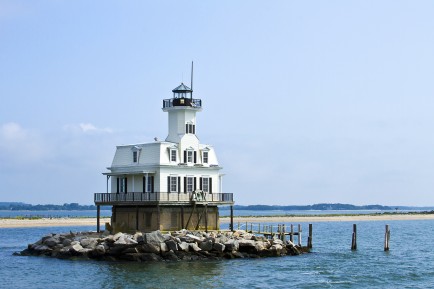North Fork Lighthouses Stand as Monuments to LI History

Long before the North Fork was dotted with wineries, sailing and fishing were the major industries on Long Island—and nothing symbolizes that legacy quite like the lighthouse. Today, three lighthouses in particular stand as monuments to this rich, seafaring heritage.
In the town of Southold, on a bluff overlooking Long Island Sound, the Horton Point Lighthouse warns sailors of a shoal just off the coast. This “schoolhouse-style” lighthouse was completed in 1857, by the National Lighthouse Service, 101 years after it was suggested by George Washington. Over the years, eight lighthouse keepers lived and served at Horton Point, until 1933, when a 40-foot steel tower with an automated light was built, and the Horton Point tower went dark. The last keeper left in 1938, after the Great Hurricane, and the building sat mostly vacant, except for a brief time during World War II, when it was used as a lookout by the Civil Defense Corps.
After the war, the unoccupied lighthouse succumbed to neglect and vandalism, and was nearly demolished. The old brick building was saved, however, by the Southold Historical Society, and the main residence of the lighthouse was repurposed in 1977 as a nautical museum, which is still open today. In 1990, the steel beacon was removed, and the Horton Point Lighthouse was returned to active service. While the Lighthouse and Nautical Museum is open from Memorial Day through Columbus day, the Horton Point Park is open year round.
For more information, contact the Southold Historical Society at 631-765-5500.
The mile-wide channel between the easternmost tip of the North Fork and Plum Island is a dangerous and highly trafficked waterway known as Plum Gut. Here, the waters of the Sound merge with those of Gardiner’s Bay, creating a churning mess of swelling waves and riptides. To make matters worse, only the eastern two-thirds of this deep channel is navigable, as the Oyster Pond Reef extends out from Long Island, lying just beneath the surface, marked only by the Orient Point Lighthouse.
The Orient Point Lighthouse, affectionately known as the “Coffee Pot” due to its shape, is a cast-iron caisson tower-style lighthouse sitting on 10,000 tons of riprap, or loose stone. Shortly after construction finished in 1899, the 45-foot-tall Coffee Pot began to tilt by about five degrees. It’s suspected that this was either caused by the heavy iron plates that were used to patch cracks and rust spots along its base, or the strong tidal currents, which may have undermined its foundation. Over the years, a number of keepers maintained the Coffee Pot, until 1958, when it was automated. With no lighthouse keeper to maintain the property, the storm-battered beacon fell into disrepair, and in 1970 the Coast Guard announced plans to replace it with a simple steel-pipe tower. The citizens of Orient Point were outraged, and rallied to save and restore their lighthouse. In 2000, the Coast Guard upgraded the Coffee Pot with solar panels and a new boat launch, only to deem the property excessive in 2011. The Coffee Pot went to auction in the summer of 2012, and was reportedly purchased in September for $120,000. While the lighthouse can be viewed from Orient Point State Park or the Cross Sound Ferry, it’s not accessible to the public.
Since 1871, the Long Beach Bar Lighthouse, or “Bug Light,” has been warning sailors of the Long Beach Bar, a sandbar that stretches out from Orient Beach State Park, nearly to Shelter Island. According to local legend, this lighthouse received its quirky nickname from sailors who thought the screw pile pylons made the lighthouse look like a giant bug on the water. The Bug Light welcomed sailors into the Orient Harbor from Gardener’s Bay for generations, until it was burned down by vandals in 1963. But in 1990, the community came together and fully rebuilt and restored the Long Beach Bar Lighthouse to its former Victorian grandeur.
Today, the Bug Light is owned and maintained by the East End Seaport Museum and Maritime Foundation, which hosts tours of the lighthouse in the spring, summer and fall.
For more information, visit eastendseaport.org.









